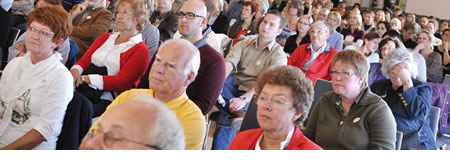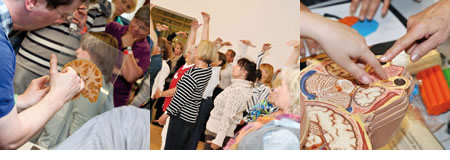BRAIN DAY 2013 – Programme
FROM FUNDAMENTAL RESEARCH TO THERAPY

A day with a focus on Bochum’s neuroscience with lectures, information stands and activities
25.09.2013, 12-5pm, RUB Conference Center
PROGRAMME
| 12:00 | BEGIN OF THE SUPPORTING PROGRAM Presentations of support groups Activities to join in |
| 13:00 | WELCOME AND OPENING Prof. Dr. Denise Manahan-Vaughan, Speaker of Collaborative Research Centre 874, Ruhr-University Bochum |
| 13:15 | TRAIN YOUR BRAIN – WHEN YOUR BRAIN GETS OLD PD Dr. Hubert Dinse, Ruhr-University Bochum |
| 13:45 | LEARNING AND NEUROPLASTICITY – NO STANDSTILL IN THE BRAIN Prof. Dr. Tobias Schmidt-Wilcke, University Clinic Bergmannsheil |
| Read more The brain never stands still. Even when we are resting, or in deep sleep the neurons are in permanent activity. Neurons and their supportive cells, so-called glial cells, form enormous networks, which constantly adapt and update themselves. Adaption is important whenever the organism is faced with a new task and must start a learning process. This means that the brain must mature not only in the beginning of life, but also later on be able to continuously reorganize itself, and change and improve certain functions, so that learning is possible. This is a process that occurs until old age. Through the use of magnetic resonance imaging we are able to look inside the active brain, enabling us to evaluate its structure, and also, indirectly, by use of the BOLD effect, its function. It is therefore possible, not only to observe the learning process, but to look at how the brain re-organizes itself. Depending on the proposed task one can see changes in the grey matter, changes in the fiber connections, and the recruitment of new brain areas. The brain is able to connect areas of the brain which are far apart, and combine them into functional units – fascinating! | |
| 14:15 | COFFEE BREAK + SUPPORTING PROGRAM |
| 16:00 | ULTRASOUND AND ROBOTICS IN NEUROSURGERY – STATUS QUO AND OUTLOOK Prof. Dr. med. Kirsten Schmieder, University Clinic Knappschaftskrankenhaus |
| Read more In an intraoperative setting the use of ultrasound, especially navigated ultrasound using a contrast medium, has proven its worth. Using ultrasound it is possible to repetitively and non-invasively receive a good resolution in a localized area. This enables us to locate a process, monitor the progress of surgery, and, within limitations, evaluate the completeness of a resection during brain tumor surgery. In contrast, robotics, apart from its limited use in the guidance of endoscopes or for rigid or semi-rigid guidance of cranial drilling instruments, is still considered an outsider-technology in neurosurgery. This talk will introduce technical developments which perform precise, reproducible robotic milling, as well as developments in the area of trepanation, meaning the opening of the skull with the use of robotic instruments. Additionally, a market-ready robotic guidance-instrument will be presented that works completely autonomously to place screws alongside the spine. In an outlook the talk will consider further possible areas of application for ultrasound and robotics. Furthermore a perspective is given for the future of multimodal monitoring and the thereby improved possibilities of tumor resection. | |
| 16:30 | THE EVOLUTION OF THINKING: PARALLEL PATHS OF DEVELOPMENT OF HIGH COGNITIVE PERFORMANCE. WE ARE NOT ALONE! Prof. Dr. Drs. h.c. Onur Güntürkün, Ruhr-University Bochum |
| Read more What are the foundations of our high cognitive abilities, which have, during the course of evolution, made us into the Homo sapiens – the wise ape? Until recently scientists believed that the cortex is the source of higher cognitive performance, and that we humans, together with the dolphins, have the largest cortex – both in absolute and in relative terms. In the meantime, evidence is mounting that birds, especially corvid species, can perform cognitive functions on par with – and sometimes even surpassing – those of chimpanzees. But birds do not even have a cortex, therefore should not be capable of complex thought processes! Neurobiological studies now show that birds have found a singular evolutionary path for the development of their forebrain and their thought processes. These findings suggest that there are many evolutionary paths for the development of complex thought processes. Homo sapiens is just one of them. |
SUPPORTING PROGRAMME

ZEN AND NEUROSCIENCES: WHEN BODY AND SOUL CONVERGE
Meditate with Dipl. Phys. Sebastian Thomas Philipp, Computational Neuroscience, Ruhr-University Bochum
Meditation has been performed for centuries in almost all cultures of the earth. The common core is a present lifestyle in the here and now, its common exercise is “sitting in silence”. On the outside nothing much happens during meditation, but on the inside there may be a lot of activity. Sebastian Philipp wants to demonstrate how meditation has the potential to trigger learning processes in the brain and how it is able to radically change our perception of ourselves and the world around us.
BRAIN SPOTS – ACTIVITIES
Bochum neuroscientists present their work.
How can neuroscientific research findings be transferred to new forms of therapy? The Neural Plasticity Lab presents chosen examples and hands-on demonstrations.
Or you can look at unique anatomic specimens and compare them to MRI (Magnetic Resonance Imaging)-scans of the brain. MRI-scans make the structure of the brain visible. But how do the MRI measurements work and how is the image created and its three-dimensional information? Functional magnetic resonance imaging (fMRI) can make the working brain visible. How is this done?
See your own pulse with medical ultrasound and learn how this technology helps diagnose and evaluate brain tumors!
What connects neuroscience research with robotics? With the help of mini robots, called ePucks, our scientists demonstrate how experimental and theoretical findings may be used to enable robots to navigate in a real environment.
INFORMATION STANDS OF THE SUPPORT GROUPS
Alzheimer Gesellschaft Bochum e.V. Demenz-Servicezentrum Region Ruhr
Aphasie-Selbsthilfegruppe Bochum
Clusterkopfschmerz-Selbsthilfe-Gruppe Recklinghausen
Deutsche Multiple Sklerose Gesellschaft Ortsvereinigung Bochum und Umgebung e.V.
Deutsche Myasthenie Gesellschaft e.V. Regionalgruppe Bochum/Dortmund
Deutsche Parkinson Vereinigung e.V. Regionalgruppe Bochum
Gesichtsfeldausfall Selbsthilfegruppe Niederrhein
Morbus Fabry Selbsthilfegruppe e.V.
Restless Legs Selbsthilfegruppe Bochum
REGISTRATION
Participation is free of charge
Please confirm your attendance via
sfb874-pr@rub.de
oder Telefon: 0234 32-26675
DIRECTION
Public Transport: subway U35 exit “Ruhr-Universität Bochum”, enter through Mensa (university cafeteria)
Car:via Universitätsstraße, Parking Deck P9, then follow signposts
Download Map Directions here.
